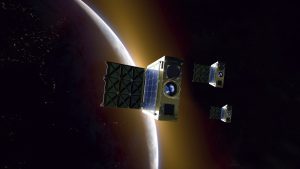What is a Satellite Platform
A satellite platform, also known as the satellite bus, refers to the structural and functional framework that houses the essential systems needed to operate a satellite. The platform provides the backbone that supports the satellite’s payload, such as cameras, sensors, or communication devices, while ensuring the satellite’s subsystems—like power supply, propulsion, and communication—function smoothly.

Key Components of a Satellite Platform
- Power System The power system is critical for a satellite’s operation. It typically relies on solar panels and batteries to generate and store energy, ensuring the satellite has a continuous power supply to operate its payload and subsystems.
- Attitude Control System Attitude control is responsible for stabilizing and orienting the satellite. This system ensures that the satellite remains properly aligned in space, allowing its sensors or communication devices to target specific regions or points of interest accurately.
- Thermal Control System Space is a harsh environment, and satellites must deal with extreme temperatures. The thermal control system maintains optimal temperatures for the satellite’s electronics and payload by using radiators and insulation, preventing overheating or freezing.
- Propulsion System The propulsion system helps adjust the satellite’s orbit and maintain its correct position in space. This system allows satellites to perform maneuvers, including orbital adjustments and collision avoidance.
- Communication System The communication system facilitates data transmission between the satellite and ground stations. This includes sending telemetry data, mission results, and receiving commands from Earth.
Importance of a Satellite Platform in Space Missions
The satellite platform plays a crucial role in the success of any space mission by ensuring the smooth operation of the payload. Its robust design and integrated subsystems allow for longer mission durations, improved performance, and higher reliability. The platform supports various types of missions, such as Earth observation, scientific research, and communications.
Satellite Platform Versus Payload
In satellite design, it’s essential to distinguish between the platform and the payload. The platform is the supporting infrastructure, while the payload is the mission-specific component that performs the satellite’s primary function. For example, in a weather satellite, the payload might be a camera or sensor used to collect atmospheric data, while the platform ensures that the sensor can operate effectively and transmit data back to Earth.
Types of Satellite Platforms
- Small Satellite Platforms Small satellite platforms are compact and efficient, supporting lightweight satellites with a reduced payload capacity. These platforms are cost-effective and widely used in low Earth orbit (LEO) missions such as CubeSats and nanosatellites.
- Medium Satellite Platforms Medium satellite platforms support a broader range of payloads and offer more power and operational flexibility. They are used for missions such as Earth observation, telecommunication, and scientific exploration.
- Large Satellite Platforms Large satellite platforms are designed for heavier payloads, supporting complex missions in geostationary orbits or interplanetary exploration. These platforms offer advanced propulsion and communication systems, allowing for extended missions and high-power applications.
Choosing the Right Satellite Platform
The choice of a satellite platform depends on various factors, including the mission’s objectives, the payload’s weight, and the desired orbit. For missions requiring high precision and advanced communication, a larger platform with more powerful subsystems may be necessary. However, for cost-sensitive missions, small or medium platforms can provide the required performance at a lower cost.
The Future of Satellite Platforms
Satellite platforms are evolving rapidly with advances in technology. Future platforms will integrate artificial intelligence (AI) and machine learning to enhance autonomy and decision-making capabilities. Moreover, modular satellite platforms will enable easier customization, allowing satellites to be adapted for multiple missions with minimal modifications.
With the growing demand for satellite services in sectors such as Earth observation, telecommunications, and navigation, the development of more efficient, reliable, and cost-effective satellite platforms will be critical for future space exploration.
Why Satellite Platform Definition Matters
Understanding the definition of a satellite platform is essential for anyone involved in satellite design, operation, or utilization. The platform serves as the foundation of the satellite, ensuring that all onboard systems work together efficiently. A well-designed satellite platform increases the chances of mission success, reduces operational costs, and extends the satellite’s operational life.
The definition also helps clarify the distinction between the satellite’s platform and payload, which is crucial for engineers, mission planners, and satellite operators. By understanding the platform’s role, stakeholders can make informed decisions about satellite design, ensuring that the payload can perform its mission effectively in space.
A satellite platform is the backbone of any satellite, providing the necessary systems and infrastructure to support the payload and achieve the mission’s goals. From power generation and attitude control to communication and thermal regulation, the platform ensures the smooth operation of the satellite in space. As technology continues to evolve, the development of next-generation satellite platforms will open new opportunities for space exploration, scientific discovery, and global communication.
